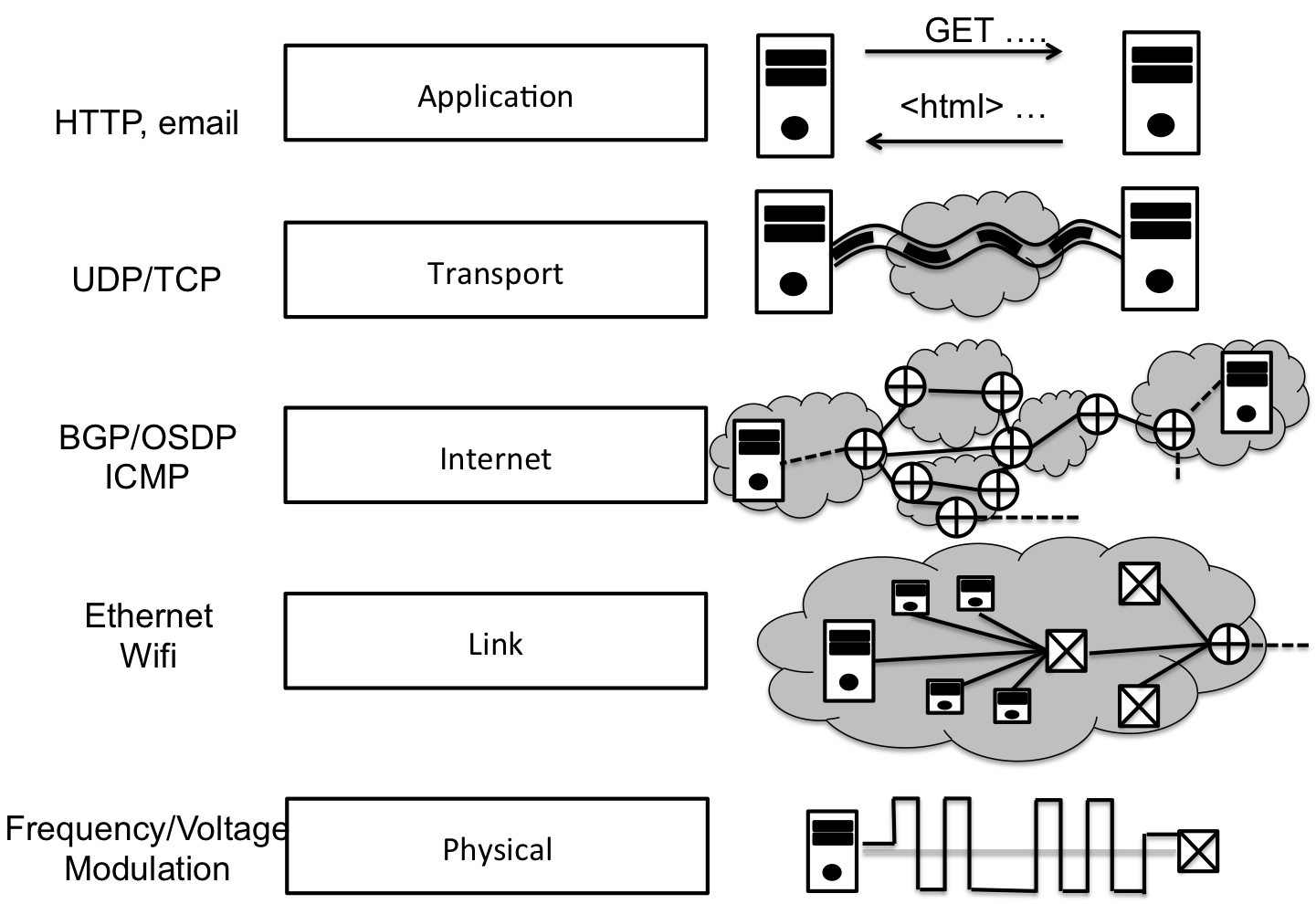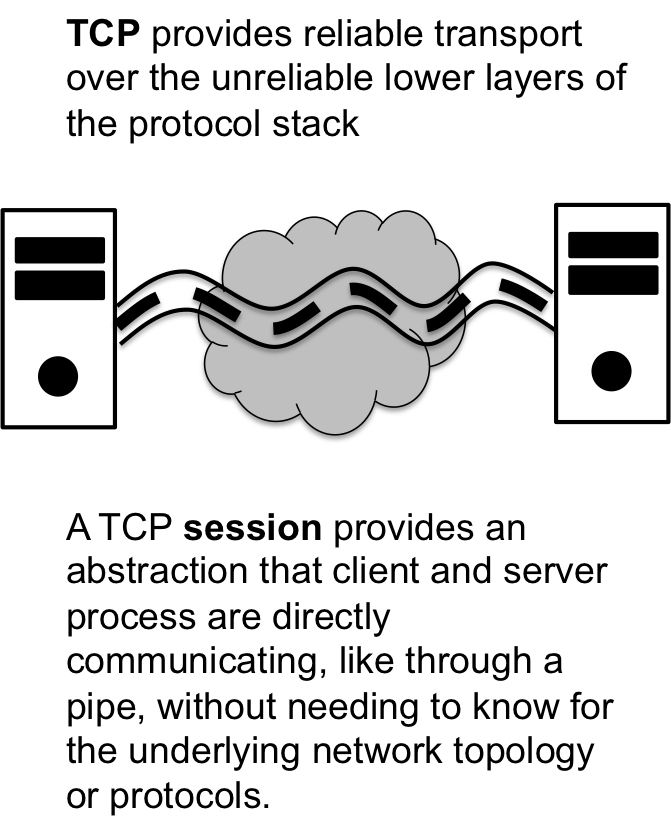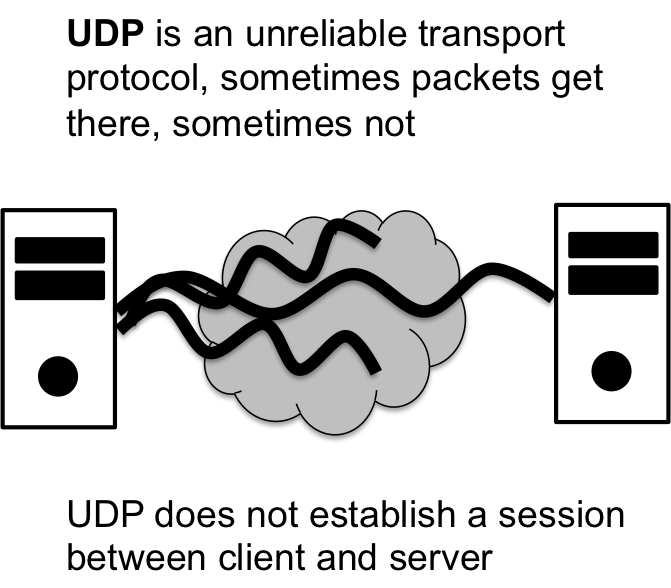Table of Contents
View all the videos from this unit a single playlist on youtube
Networking #
What is the internet? #
The Internet by definition is a network of networks composed of computers. As a non-technical term, we use the term Internet as a catchall for all connected computers, but in technical terms, it is just one part of a larger ecosystem of networks and protocols that enable the sharing of information.
This is not a class on networking or the internet, but the ability to communicate over a network is an integral part of modern programming that fits nicely within the OOP models of IO we’ve been discussing with Java so far. But, to really understand network programming, you have to first have a decent understanding of the protocols that underly the Internet, and one thing you learn quickly about network programming is that the protocol is king. Understanding the protocols is will make you a better programmer.
Packet Switching #
The internet is a packet switched network. A packet is defined as follows:

All packets have a header, which stores the address or destination of a packet, and a payload which stores the data or message of the packet. The switching part of packet switching is that at network devices, like routers and switches, the packet arrives, and based solely on the header of the packet, the device knows where to send the data next. There are no pre-defined routs for data but the protocols ensure that the next hop in the path to the destination can be determined. As you might imagine, in such a model, addressing becomes very important.
The TCP/IP Protocol Stack #
The Internet is modelled as a protocol stack where each protocol defines a different interaction layer. Information flows up and down the protocol stack, and at each layer, a different protocol comes to bare for forwarding the packet onward to the next hop.

Each layer has different goal in mind. Starting with the physical layer, the main purpose is to actually transmit 1’s and 0’s over medium, like a wire. The link layer adds protocols for how the medium is shared across many connected devices, as well as error correction. An example of protocols on the link layer is ethernet or wifi.
The internet and transport layer of are particular interest in this class because you will interact directly with these protocol through their addressing schemes. The purpose of the internet layer is to inter-connect networks; for example,e GW has a network, and if you want to send data to Google, your packets must traverse GW network and potentially many other federated networks before finally reaching a server at Google. The internet layer both describes the protocols for how networks inter connect with each other and the way that computers are identified, via the internet protocol address or ip address.
At a certain point, though, two processes running on different computers are actually sending and receiving data across the vastness of the Internet. The transport layer provides an abstraction for those two process to apear as if they are communicating directly with each other. Since many process can be communicating on the network at the same time, the transport layer also provides a mechanism, called ports, to differentiate communication destined for one process versus another.
Finally, at the application layer, additional protocols are available depending on the task at hand. For example, SMTP is used to transmit email messages and HTTP is used to download web content and BitTorrent is used to pirate music and videos :) From a generic programmers perspective, the application layer is the domain where we get to choose what data is sent and received and how that data is interpreted; the systems programming perspective also concerns itself with system calls that enable that communication.
Internet Addressing #
Each layer has its own addressing scheme and information needed to perform routing/switching. This information is traditionally encoded within the header of the packet. There are two key addressing systems that we will use in this class, ip addresses and ports. Additionally, we also refer to computers by name, a domain name, which must be translated into an address.
IP Addresses #
An ip address is a 4-byte/32-bit number in Version 4 of TCP/IP protocol. We usually represented in a dotted quad notation:
4-bytes
_____________
/ \
192.168.128.101
\_/
|
1 byte
A byte is 8-bits, and thus can represent numbers between 0-255, which is why ip addresses do not have numbers greater than 255. The ip address is hierarchical where bytes to the left are more general while bytes to the right are more general. Based on a subset of the bytes, routers can determine where to send a packet next.
Domain Names and Hosts #
While IP addresses are somewhat usable, it is quite a burden to memorize the ip address of all the computers we might want to vist on the web. For exampel, while I might know the ip address of a single computer off hand, e.g., “10.53.37.142” is the ip address of a lab machine, I can’t recall the ip address of Google or Facebook or much of anything else.
Instead, we use domain names to identify a networked device. A hostname, is a dotted string of names, usually ending in the canonical .com or .org or .edu or .gov or etc. For example, the domain name for Google is google.com, but the Internet does not function on domain names. It needs IP addresses. A separate protocol called the Domain Name Service or DNS is tasked with converting domain names into IP addresses.
We can access the DNS system on Unix through the host command. For example, suppose we wanted to learn the IP address of google.com:
#> google.com
google.com has address 74.125.228.110
google.com has address 74.125.228.103
google.com has address 74.125.228.96
google.com has address 74.125.228.99
google.com has address 74.125.228.104
google.com has address 74.125.228.101
google.com has address 74.125.228.102
google.com has address 74.125.228.97
google.com has address 74.125.228.100
google.com has address 74.125.228.105
google.com has address 74.125.228.98
google.com has IPv6 address 2607:f8b0:4004:803::1003
google.com mail is handled by 30 alt2.aspmx.l.google.com.
google.com mail is handled by 40 alt3.aspmx.l.google.com.
google.com mail is handled by 20 alt1.aspmx.l.google.com.
google.com mail is handled by 10 aspmx.l.google.com.
google.com mail is handled by 50 alt4.aspmx.l.google.com.
The output may not be what you expect. There are many, many different IP addresses available to server google.com, and this is by intention to balance the load of request across multiple machines. In fact, every time you rerun host, you’ll find that you get a different set of IP address:
#> host google.com
google.com has address 74.125.228.104
google.com has address 74.125.228.101
google.com has address 74.125.228.102
google.com has address 74.125.228.97
google.com has address 74.125.228.100
google.com has address 74.125.228.105
google.com has address 74.125.228.98
google.com has address 74.125.228.110
google.com has address 74.125.228.103
google.com has address 74.125.228.96
google.com has address 74.125.228.99
google.com has IPv6 address 2607:f8b0:4004:803::1003
google.com mail is handled by 50 alt4.aspmx.l.google.com.
google.com mail is handled by 30 alt2.aspmx.l.google.com.
google.com mail is handled by 40 alt3.aspmx.l.google.com.
google.com mail is handled by 20 alt1.aspmx.l.google.com.
google.com mail is handled by 10 aspmx.l.google.com.
If we were to query a less used domain name, one that isn’t serving as much traffic as google, we get IP addresses that are a bit more sane. For example, let’s see what the IP addresses are for www.cs.gwu.edu:
$ host www.cs.gwu.edu
www.cs.gwu.edu is an alias for www2old.gwu.edu.
www2old.gwu.edu has address 161.253.128.45
Interesting, you can see that www.cs.gwu.edu is an analias for another domain www2old.gwu.edu, which in turn has a stable IP address 161.253.128.45.
Ports #
The last bits of addressing relevant to this class is the port address. While the IP address is used to deliver packets to a destination computer, the port address is used to deliver the packets on the computer to the right process. Consider that a single computer all share the same IP address, there are many different applications using that connection at the same time. You might have multiple web pages open with email and playing games and etc, each of those interactions is performed by a separate process but all the data arrives at the computer through a single point.
The port address is a way for the Operating System to divide up the data arriving from the network based on the destination process. Additionally, ports tend to be tightly coupled with applications. For example, to initiate a HTTP connection for web browsing, you connect using port 80; to initiate a secure shell connection with ssh, you connect using port 22; and, to initiate a connection to send email, you connect using port 25, and so on. What makes ports important is that all those services, web server, ssh, and email, can all be running on the same computer. The ports allows the operating system differentiate traffic for each application.
Client/Server Model #
Most interactions of applications are dictated by the client-server model. In this model there exists clients who are requesting a services for a server.

In the model, we describe clients as connecting to servers and servers listening to incoming connections. When a connection is established, or data is received, the server replies to the client with data as required by the application protocol.
While this class will focus on the client server model, there are other models of network interaction. For example, the peer-to-peer model is when clients act as both client and servers. This is common for many distributed systems, such as BitTorrent or Skype.
Reliable Transportation: TCP #
The client server model fits into the protocol stack at the transport layer. There are typically two types of transport available for programmers, reliable and unreliable transport. Interestingly, none of the protocols in lower layers ensure any reliability — at any time packets can be drop, misrouted, delayed, or generally deformed without notice. The fact that such things can happen on the network is actually a positive because the lower layers can be much more efficient without having to worry about reliable delivery.

Unreliable Transport: UDP #
Reliable transport has a cost, though. The cost is the retransmission of lost or deformed packets and acknowledgments of properly received packets. In order to have reliable transportation, all information must be properly acknowledged upon receipt and if a packet was not properly received, then it must be retransmitted. The result is that there exists a significant overhead, and this is worsened by the fact that not all communication needs to be reliable — dropping a few packets here and there never killed anyone, yet.
The complementary protocol to TCP is UDP or User Datagram Protocol, which is an unreliable transport mechanism. The UDP protocol, or DATAGRAM protocol, does not make any guarentees about the delivery if a packet. It might get there … or it might not. Datagram protocols are not session driven either; without reliability, the client and the server need not stay in sync to ensure that all messages are acknowledged. Instead, a server just listens for incoming data from clients and thats that.

You might be wondering when would this ever be useful? UDP is quite common for a number of applications; for example, live audio streams. There is no need for audio streams to be reliable, if you miss a packet, so what, you’ll just get the next one and keep playing the music. However, if you were to do this reliably, you’d have to stop the music while missed data was retransmitted, and the result is you might keep getting further and further behind in the live stream.
Socket Programming in Java #
Now that you have a good idea of how networking works, we turn our attention to how Java enables access to networking API. At this point, it shouldn’t surprising you that this occurs via Objects and that it fits into an already established framework of I/O. That means communicating over the network in a programmatic way is similar to read/writing to files, except the endpoint is not a file, but rather a remote computer.
Java divides socket programming into server and client programming. There are two main classes
We’ll review using both below. And if you want more information, Oracle offers a nice tutorial of using sockets
The Socket class #
In Java, the Socket class is used as the client socket in a two-way communication with a server. Key to this idea is that the socket is connected to the server at a ipaddress/host and port. The main constructor you’ll use is
Socket(String host, int port);
//Creates a TCP stream socket and connects
//it to the specified port number on the named host.
Note that all
Sockets in java are TCP (SOCKSTREAM) sockets, if you want to use a different socket type, you’ll need to use one of the other socket classes, likeDatagramSocket.
Importantly, the Socket is to connect to the server, but communication with the server is a two-way procedure. So once we connect to the server, we can both read and write to the socket via the socket’s InputStream and OutputStream. And like with other I/O we can wrap those streams in other buffered readers/writers.
Let’s start with a “Hello World” example of a client connecting to a server and writing “Hello World”. Our basic program looks like the following
import java.util.*;
import java.net.*;
import java.io.*;
public class HelloSocket{
public static void main(String args[]){
Socket sock=null;
try{
sock = new Socket("localhost",2021);
}catch(Exception e){
System.err.println("Cannot Connect");
System.exit(1);
}
try{
PrintWriter pw = new PrintWriter(sock.getOutputStream());
pw.println("HelloWorld");
pw.close(); //close the stream
sock.close();//close the socket
}catch(Exception e){
System.err.print("IOException");
System.exit(1);
}
}
}
Note that we need the try/catch blocks because there are a number of errors that can occur when dealing with I/O.
The socket is two-way, so we can also “read” for input after having written to the socket. This is a small expansion of the above program
try{
PrintWriter pw = new PrintWriter(sock.getOutputStream());
pw.println("HelloWorld");
pw.flush(); //flush the output (recall PrintWriters buffer)
BufferedReader in =
new BufferedReader(
new InputStreamReader(sock.getInputStream()));
String reply = in.readLine();//read a line from ther server
System.out.println("Server said: "+reply);
pw.close(); //close the stream
in.close();//close the input stream
sock.close();//close the socket
}catch(Exception e){
System.err.print("IOException");
System.exit(1);
}
Now when we run the program, we can type input after “HelloWorld” which get’s written to our client.
The ServerSocket class #
The server side of this works pretty much like the client side, except for an additional step of the server needing to accept an incoming connect. The key class is the ServerSocket which we initialize like so
ServerSocket serverSocket = new ServerSocket(portNumber);
The portNumber is which port we want to be listening for on an incoming connection. Once the serverSocket is established we call accept(), which returns a new Socket that is used to communicate with that client.
Socket clientSocket = serverSocket.accept();
Importantly, the server socket can accept more connections from other client sockets. That is why a new socket is created for each client.
To demonstrate this, we want to create a “Hello World” server that writes “Hello World” every time you connect to it. We put the accept call in a loop.
import java.util.*;
import java.net.*;
import java.io.*;
public class HelloServer{
public static void main(String args[]){
ServerSocket serverSock=null;
try{
serverSock = new ServerSocket(2021);
}catch(Exception e){
System.err.println("Cannot open server socket");
System.exit(1);
}
try{
while(true){
Socket clientSock = serverSock.accept();
System.out.println("Connection from: "+clientSock.getRemoteSocketAddress());
PrintWriter pw = new PrintWriter(clientSock.getOutputStream());
pw.println("Hello World");
pw.close(); //close the stream
clientSock.close();//close the socket
//loop and get the new connection
}
}catch(Exception e){
System.err.print("IOException");
System.exit(1);
}
}
}
Note that we can easily see who is connecting to the server by retrieving the remote socket address and print that out.
Each connection comes from 127.0.0.1, which is the IP address used when connecting within a single localhost computer. Also note that the port changes each time, that’s because once the connection is established, the server is still listening on the original port 2021, so this new connection should use a different port
Threaded Echo Socket Server #
The final step in programming a sockets is to consider the threaded socket server. A threaded socket server starts a new thread for each thread so that the main thread can continue to listen to incoming connections. To understand why this would be needed, consider that in the example above that while the server is printing to the client, another client may be queued to connect. In this example, this is probably fine because the action the server does is somewhat complex, but let’s consider a more complex server that echos back to the client anything written to the socket until the client closes the socket.
You should be able to trace the function of this program now …
import java.util.*;
import java.net.*;
import java.io.*;
public class EchoSocketServer{
ServerSocket serverSock;
public EchoSocketServer(int port){
try{
serverSock = new ServerSocket(port);
}catch(Exception e){
System.err.println("Cannot establish server socket");
System.exit(1);
}
}
public void serve(){
while(true){
try{
//accept incoming connection
Socket clientSock = serverSock.accept();
System.out.println("New connection: "+clientSock.getRemoteSocketAddress());
//start the thread
(new ClientHandler(clientSock)).start();
//continue looping
}catch(Exception e){} //exit serve if exception
}
}
private class ClientHandler extends Thread{
Socket sock;
public ClientHandler(Socket sock){
this.sock=sock;
}
public void run(){
PrintWriter out=null;
BufferedReader in=null;
try{
out = new PrintWriter(sock.getOutputStream());
in = new BufferedReader(new InputStreamReader(sock.getInputStream()));
//read and echo back forever!
while(true){
String msg = in.readLine();
if(msg == null) break; //read null, remote closed
out.println(msg);
out.flush();
}
//close the connections
out.close();
in.close();
sock.close();
}catch(Exception e){}
//note the loss of the connection
System.out.println("Connection lost: "+sock.getRemoteSocketAddress());
}
}
public static void main(String args[]){
EchoSocketServer server = new EchoSocketServer(2021);
server.serve();
}
}
On your own, can you write an EchoClient and connect it to the server so that they go back and forth for ever!!!